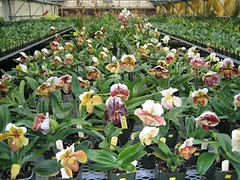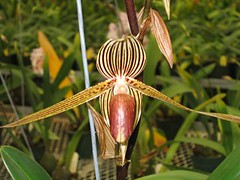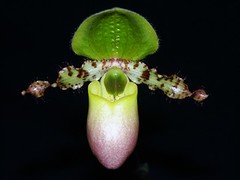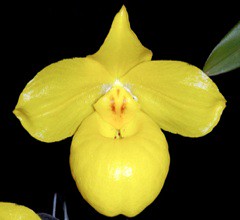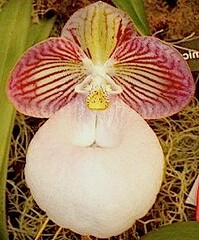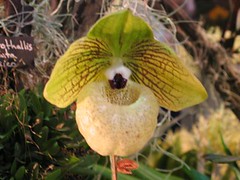Paphiopedilum orchids are the most commonly grown lady slipper orchids because they are more adaptable to cultivation than other kinds of ladyslippers. People who love Paphiopedilum are truly nuts about them, and some even believe it should be considered a separate family of its own. That’s quite understandable. The bizarre pouch-like lips are nothing like other flowers. The bottom sepals are merged to form a synsepal. The dorsal sepal is large and showy. In many slipper orchids, the two petals are quite flamboyant (imagine if Elton John were a flower); they can be so long as to reach 3 feet (1 meter) long in the case of Paphiopedilum sanderianum. It’s an awesome sight when the curly petals flow with the wind. Some Paphiopedilum even have warts and hair that are irresistible in a different way.
The 60 Paphiopedilum species are native to India, southern China, New Guinea and the Philippines. The first Paphiopedilum hybrid was registered in 1869, and now the genus is by far the single most hybridized orchid. These 13,000 wonderful hybrids are available in myriad colors, sizes and shapes. They can easily be grown at home, and each flower can provide you weeks, if not months, of enjoyment.
Flower
Paphiopedilum orchids send out one flower spike on each new growth, so when flowering is done, you’ll have to wait for a new growth to mature before you see flowers again. However, the good news is that some slipper orchids have as many as 10 flowers on each spike, some bloom simultaneously and some bloom sequentially. Example of these types are Paphiopedilum rothschildianum and primulinum. Some skilled growers report that their sequential bloomers have been flowering for five years!
However, the slipper orchids that produce single flowers are quite lovely too. Examples are the bright-yellow armenicum, the huge-pouched micranthum and the raspberry-scented malipoense.
How to Grow Them
Slipper orchids are good houseplant because they like low to medium light. They can be grown on east-, south- or west-facing windowsills. The plain-leaf Paphiopedilum requires slightly more light than the mottled-leaf kind, so they will like a southeastern-facing window. Of course, all of them also can be grown under artificial lights.
The mottled-leaf types of Paphiopedilum are warm to intermediate growers. They like night temperatures between 55 and 65°F (13 and 18°C) and day temperatures between 65 and 75°F (18 and 24°C). On the other hand, the plain-leaf kind likes cooler temperatures, with night between 45 and 55°F (7 and 13°C) and day between 55 and 65°F (13 and 18°C).
Paphiopedilum does not like to dry out completely. Use good quality water on these beauties and fertilize them bi-weekly at a quarter of the strength instructed on the label. Water without any fertilizer every 3 or 4 watering to rinse away any excess fertilizer and prevent buildup.
Grow these orchids in small deep pots to accommodate the large furry root system. You can pot them in bark, perlite, charcoal along with sphagnum moss to retain moisture. Alternatively, you can substitute bark with coconut husk chips as they do not break down as quickly. Just be sure to wash coconut husk chips very well to get rid of any remaining salt before potting. Salt will burn orchids’ roots.
Slipper orchids are less sensitive to low humidity because of the low light they receive. But humidity that is too low can cause the buds to die prematurely, so you should make sure the humidity does not drop below 40%.
Happy Growing!

